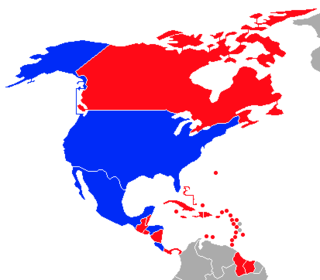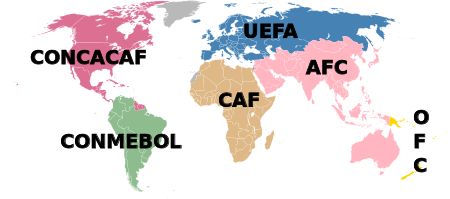The 2006 FIFA World Cup qualification competition was a series of tournaments organised by the six FIFA confederations. Each confederation – the AFC (Asia), CAF (Africa), CONCACAF, CONMEBOL, OFC (Oceania), and UEFA (Europe) – was allocated a certain number of the 32 places at the tournament. A total of 197 teams entered the qualification process for the 2006 FIFA World Cup. In 2001 FIFA ended automatic qualification of the reigning champion, so that 2002 champions Brazil became first to participate in the qualifying tournament. The hosts (Germany) retained their automatic spot.
The 2002 FIFA World Cup qualification competition was a series of tournaments organised by the six FIFA confederations. Each confederation — the AFC (Asia), CAF (Africa), CONCACAF, CONMEBOL, OFC (Oceania), and UEFA (Europe) — was allocated a certain number of the 32 places at the tournament. 199 teams entered the tournament qualification rounds, competing for 32 spots in the final tournament. South Korea and Japan, as the co-hosts, and France, as the defending champions, qualified automatically, leaving 29 spots open for competition.
The qualification competition for the 1990 FIFA World Cup was a series of tournaments organised by the six FIFA confederations. Each confederation — the Asian Football Confederation (AFC), Confederation of African Football (CAF), CONCACAF, CONMEBOL, Oceania Football Confederation (OFC), and UEFA (Europe) — was allocated a certain number of the 24 places at the tournament. A total of 116 teams entered the competition, with Italy, as the host, and Argentina, as the holders, qualifying for the final tournament automatically.
The 1994 FIFA World Cup qualification was a series of tournaments organised by the six FIFA confederations. The 1994 FIFA World Cup featured 24 teams with one place reserved for the host nation, United States, and one place for the defending champions, Germany. The remaining 22 places were determined by a qualification process, in which 147 teams, from the six FIFA confederations, competed. Most of the successful teams were determined within these confederations, with a limited number of inter-confederation play-offs occurring at the end of the process.
The 1998 FIFA World Cup qualification competition was a series of tournaments organised by the six FIFA confederations. Each confederation — the AFC (Asia), CAF (Africa), CONCACAF, CONMEBOL, OFC (Oceania), and UEFA (Europe) — was allocated a certain number of the 32 places at the 1998 FIFA World Cup. 174 teams entered the qualification rounds, while two places were reserved for France and Brazil as host nation and defending champions, respectively.
Qualifying for the 2010 FIFA World Cup was a series of tournaments organised by the six FIFA confederations. Each confederation – the AFC (Asia), CAF (Africa), CONCACAF, CONMEBOL, OFC (Oceania), and UEFA (Europe) – was allocated a certain number of the 32 places at the tournament. A total of 205 teams entered the qualification competition, with South Africa, as the host, qualifying for the World Cup automatically. The first qualification matches were played on 25 August 2007 and qualification concluded on 18 November 2009. Overall, 2,338 goals were scored over 852 matches, scoring on average 2.74 per match.
The CONCACAF qualification stage for the 2010 FIFA World Cup in South Africa consisted of 35 national teams competing for the three berths given automatically to CONCACAF by FIFA. The United States, Mexico and Honduras qualified. The fourth-place finisher, Costa Rica, played a two-game playoff with the CONMEBOL fifth-place finisher, Uruguay, for a possible fourth berth.
The Asian Football Confederation (AFC) section of the 2014 FIFA World Cup qualification saw 43 teams competing for 4 or 5 berths in the final tournament in Brazil. As in recent tournaments the AFC had four direct qualifiers for the finals tournament in addition to a further possible place via the intercontinental play-offs against CONMEBOL's fifth-placed team, which was chosen through a random draw, rather than being decided by FIFA beforehand as in previous tournaments. Iran and South Korea from Group A, along with Australia and Japan from Group B won the 4 direct qualification positions, with Jordan defeating Uzbekistan in a play-off to see which team would face the 5th placed CONMEBOL team, Uruguay, for a place in the World Cup, eventually also failed to qualify for the competition.

The CONCACAF qualification for the 2014 FIFA World Cup consisted of four rounds of competition, in which the 35 member nations competed for three automatic berths at the finals in Brazil.
The OFC qualification for the 2014 FIFA World Cup saw teams of the Oceania Football Confederation competing for a place in the finals held in Brazil.
The 2012 OFC Nations Cup was the ninth edition of the OFC Nations Cup organised by the Oceania Football Confederation (OFC). The group stage of the tournament also doubled as the second round of the OFC qualification tournament for the 2014 FIFA World Cup. The four semi-finalists advanced to the final round of OFC qualifying, where they would compete for the OFC spot in the inter-confederation play-offs. The qualifying tournament was to be the football competition at the 2011 Pacific Games in Nouméa, New Caledonia. However, in June 2011 the format was amended, and the Pacific Games were no longer part of the qualification process. The new structure saw four of the lowest ranked entrants play a single round-robin tournament from 22 to 26 November 2011 in Samoa. The winner of this qualifying stage joined the other seven teams that received a bye to the Nations Cup proper.
The 2018 FIFA World Cup qualification process was a series of tournaments organised by the six FIFA confederations to decide 31 of the 32 teams which would play in the 2018 FIFA World Cup, with Russia qualifying automatically as hosts. All 210 remaining FIFA member associations were eligible to enter the qualifying process, and for the first time in World Cup history, all eligible national teams registered for the preliminary competition, but Zimbabwe and Indonesia were disqualified before playing their first matches. Bhutan, South Sudan, Gibraltar and Kosovo made their FIFA World Cup qualification debuts, while Myanmar participated after successfully appealing against a ban from the competition, although the team was obliged to play its home matches outside the country.
The 2022 FIFA World Cup qualification was the qualifying process which decided the 31 teams that would join hosts Qatar, who received an automatic spot, at the 2022 FIFA World Cup.

The association football tournament at the 2016 Summer Olympics was held from 3 to 20 August in Brazil.

The qualification for the 2015 FIFA Women's World Cup determined which 23 teams joined Canada, the hosts of the 2015 tournament, to play for the Women's World Cup.
Association football is one of the popular sports in Oceania, and 2 members of the Oceania Football Confederation (OFC) have competed at the sport's biggest event – the men's FIFA World Cup.
The Oceanian section of the 2018 FIFA World Cup qualification acted as qualifiers for the 2018 FIFA World Cup, to be held in Russia, for national teams which are members of the Oceania Football Confederation (OFC). A total of 0.5 slots in the final tournament was available for OFC teams.

The 2026 FIFA World Cup qualification will decide the teams that will join hosts Canada, Mexico and the United States at the 2026 FIFA World Cup.
The 2019 FIFA Women's World Cup qualification process decided all 24 teams which played in the 2019 FIFA Women's World Cup, with the hosts France qualifying automatically. It is the eighth FIFA Women's World Cup, the quadrennial international women's football world championship tournament. The tournament is the third to be hosted in Europe, after the 1995 FIFA Women's World Cup in Sweden and the 2011 FIFA Women's World Cup in Germany.

In association football, the term Hexagonal was often used to refer to the final round of FIFA World Cup qualification among the six remaining teams in CONCACAF. The six-team round robin format was used by CONCACAF since the 1998 FIFA World Cup qualification process, up until the 2018 tournament. For 2022, this round was expanded to eight teams or an octagonal. It was modeled after the CONCACAF Championship which used the format ever since its second edition in 1965, and served as the World Cup qualifying tournament from 1974 to 1990.







